Resin-bound gravel gets slippery when muck, algae and poor fitting take their toll. Common trouble spots include shady corners of your garden path or driveway where water lingers. The type of stone matters – smoother pebbles offer less grip than angular ones.
Sort it by:
- Applying anti-slip treatment (like those used on pool surrounds)
- Regular brushing and pressure washing to shift dirt
- Ensuring proper installation with correct drainage
If you’re planning a new installation, choose stones with good texture and make sure your installer knows their stuff. For existing surfaces, a twice-yearly deep clean works wonders to keep things safe underfoot.
Key Takeaways
Resin-Bound Gravel: Tackling Slippery Surfaces
Slippery patches typically develop where dirt, algae and moss build up – you’ll spot these mainly in shaded spots or areas that don’t drain properly. Think of those damp corners behind garden sheds or beneath large trees.
The type of stone matters enormously. Angular, rough-textured aggregates offer better grip, whilst rounded pebbles can turn treacherous when wet – much like walking on marbles.
Keep your surface safe with regular maintenance:
- Blast away grime with a pressure washer
- Sweep up leaves and debris frequently
- Tackle weeds as soon as they appear
For extra grip, consider:
- Anti-slip treatments (particularly vital for steep driveways)
- Protective sealants to guard against water damage
- Monthly checks for worn patches
Simple maintenance saves hassle later. A quick sweep and occasional power wash will keep your resin-bound surface looking smart and, more importantly, safe to walk on year-round.
Causes of Slipperiness on Resin-Bound Gravel
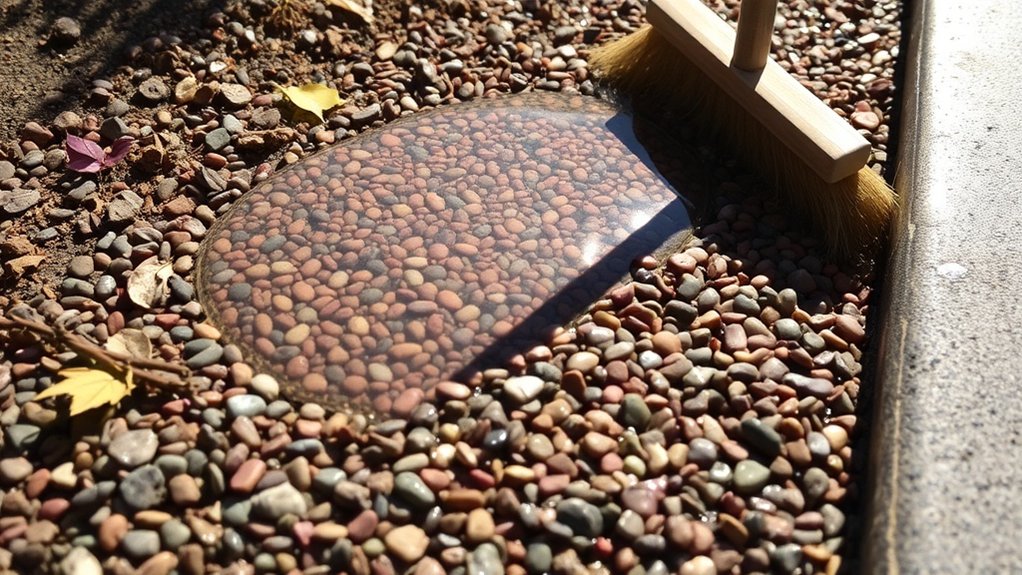
Common causes of slippery resin-bound gravel surfaces include dirt build-up and pesky algae growth.
Think of it like your garden path – when leaves and mud collect, they form a slick layer that’s quite treacherous underfoot. Poor drainage and damp weather make matters worse by creating perfect conditions for moss and algae to flourish, particularly in shaded spots where the sun rarely reaches. These biological nasties hold onto moisture, keeping the surface consistently wet and slippery. It’s much like a mossy patio – without proper maintenance, the problem only gets worse. Additionally, surface texture is crucial for preventing slipperiness, as coarser aggregates can enhance grip on your driveway. Ensuring proper drainage is also essential, as it helps to prevent moisture accumulation that encourages algae growth.
The solution? Regular cleaning is absolutely vital. A quick sweep and occasional pressure wash can prevent these issues from developing in the first place, keeping your resin-bound surface safe and slip-free.
Role of Surface Texture and Materials
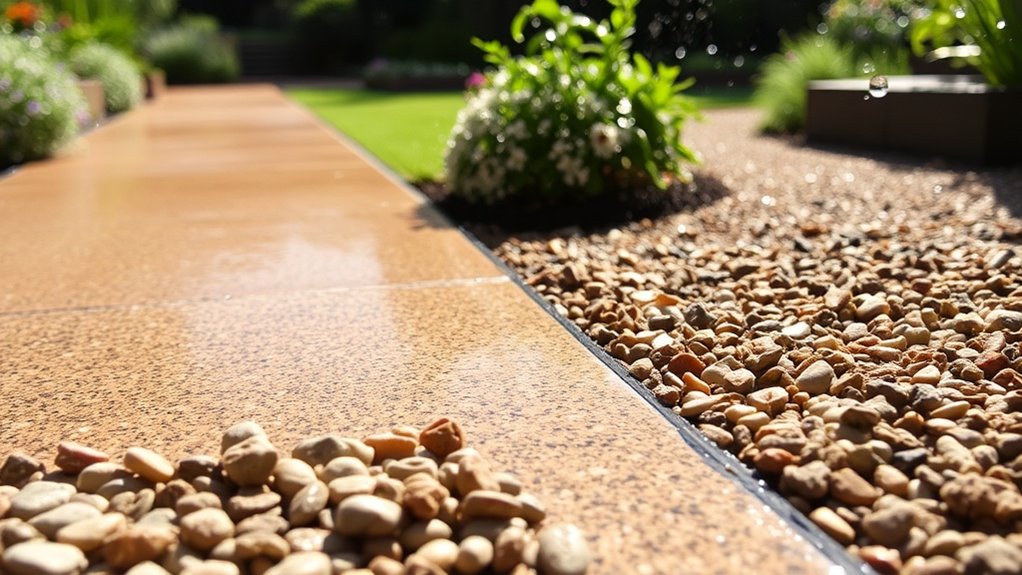
Surface texture and materials play a vital role in how safe and effective resin-bound gravel performs. Your aggregate choice shapes the surface’s grip – think of coarse, jagged stones offering better traction compared to smooth, rounded ones.
While a smooth finish might look smart, it can become quite slick when wet or dirty. The way the resin binds with the stones creates tiny surface patterns that affect grip. Proper care ensures the surface’s longevity and appearance of the surface. Additionally, using anti-slip aggregates can significantly enhance the safety of the surface in wet conditions.
If there’s not enough resin to hold everything together, loose stones can create a hazardous surface. For best results, balance looks with safety by choosing the right mix of stones and finish for your local weather conditions.
Installation and Material Quality Factors
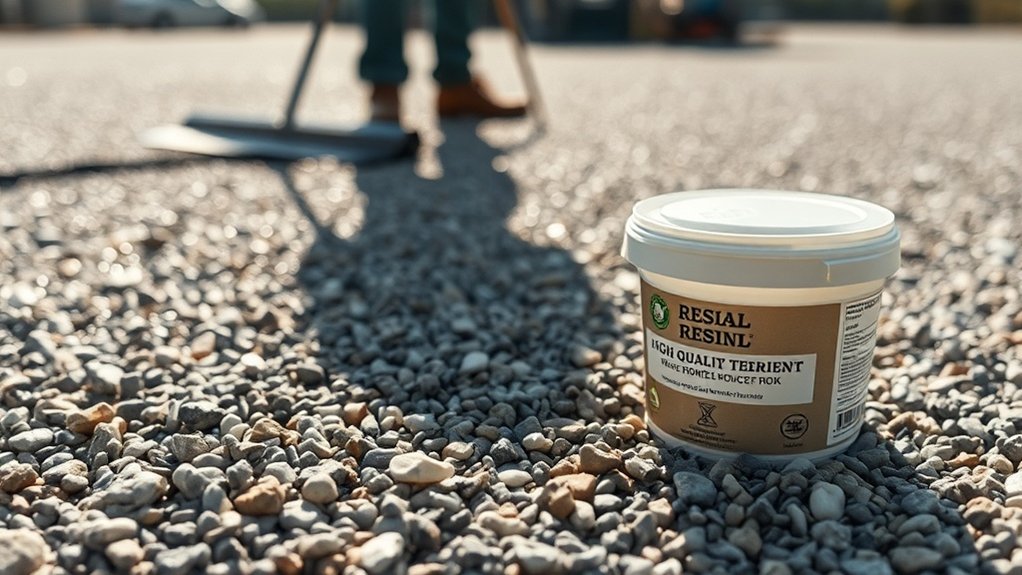
Proper installation of resin-bound gravel demands a precise resin mix ratio to ensure lasting quality. While DIY might seem tempting, professional fitting by qualified installers proves essential – they’ll spot potential problems before they become costly headaches. A skilled team knows exactly how temperature affects curing times and can properly prepare the sub-base, crucial factors that directly impact your surface’s lifespan and safety. Think of it like baking: exact measurements and proper technique make the difference between success and failure. Additionally, proper preparation is crucial for the mixture to set correctly. The use of a forced action mixer ensures an even coating of the aggregates, contributing significantly to the durability of the surface.
Consistency in Resin Mix
Getting the resin mix right is crucial for long-lasting resin-bound gravel surfaces. The resin-to-aggregate ratio must be spot-on – too little resin creates a weak surface, whilst too much makes it brittle.
Think of it like baking a cake; the ingredients need proper measuring for the best results.
Use forced action mixers to blend everything evenly, much like a cement mixer but designed specifically for resin.
Keep your aggregates clean and dry – dust or dampness will stop the resin from bonding properly.
For the right thickness, follow the simple “three times the largest aggregate” rule. For example, if your largest stone is 6mm, aim for an 18mm layer thickness. This ensures every stone gets properly coated.
These careful steps create a surface that’s durable, grippy and stable – exactly what you’d want for a British driveway that needs to handle our varied weather.
Professional Installation Importance
Professional installation is vital for resin-bound gravel surfaces to perform properly. A skilled contractor ensures the correct base preparation, including proper excavation and sub-base compaction, which prevents cracking and surface issues.
The thickness must be at least 18mm throughout – a measurement that DIY attempts often struggle to maintain consistently.
Getting the mix right is equally crucial. Professional installers know the exact resin-to-aggregate ratios needed for your specific project, much like how a baker needs precise measurements for a successful cake.
They’ll also source high-quality materials that meet British Standards, rather than cutting corners with cheaper alternatives that might fail quickly.
Think of it like laying a house foundation – get it wrong at the start, and you’ll face problems later.
A properly installed resin-bound surface will remain slip-resistant and attractive for years, whilst amateur installations often lead to costly repairs within months.
The initial investment in professional installation typically saves money in the long run.
Maintenance Issues Contributing to Slipperiness
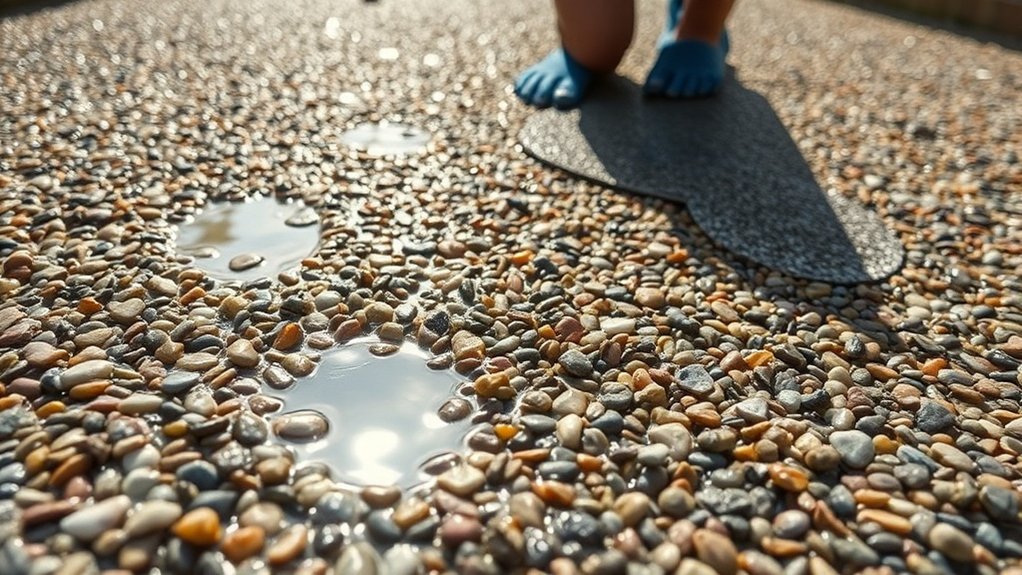
Maintenance Issues That Make Surfaces Slippery
Resin-bound gravel becomes slippery when not properly maintained, much like a wet garden path. The main culprits are debris build-up and biological growth. Dead leaves and soil clog the surface’s drainage, creating wet spots where moss and algae flourish – similar to what you’d see on a damp patio.
To tackle this:
- Clear debris regularly with a stiff brush or leaf blower (avoid metal tools)
- Remove weeds as soon as they appear, roots and all
- Check for loose stones, especially in high-traffic areas
- Inspect the surface monthly for signs of wear
Think of it like maintaining your garden path – regular sweeping and weeding keeps it safe and slip-free.
Without proper care, organic matter builds up and creates a slick surface, particularly dangerous during British wet weather. Regular maintenance isn’t just about looks – it’s essential for keeping the surface grippy and safe to walk on.
Remedies and Anti-slip Enhancements
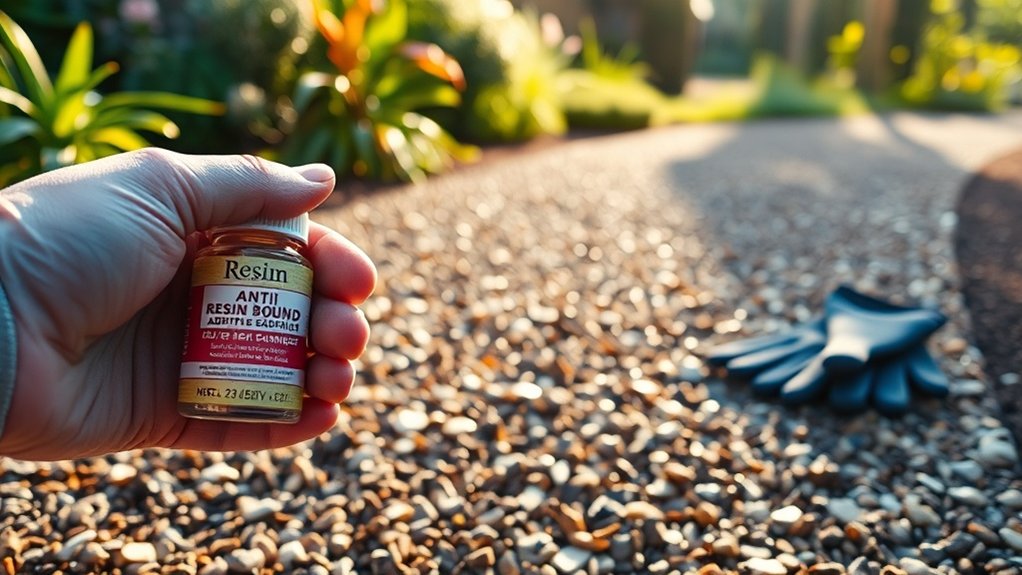
Anti-slip solutions for resin-bound gravel go beyond basic maintenance.
Adding anti-slip treatments with glass or grit creates better grip, whilst proper aggregate choice makes a real difference.
Mix different-sized stones like quartz or pea gravel to boost traction naturally.
Watch your resin levels – too much creates a slippery top layer that defeats the purpose.
Getting the balance right between aggregate and resin is crucial.
Should your surface become slick, you can either rough it up mechanically or apply specialist treatments to restore grip.
Done properly, these measures keep your resin-bound surface safe in all weather, from summer heat to winter rain.
Think of it like choosing trainers with good grip – the right texture makes all the difference when it’s wet or icy outside.
Environmental and Usage Considerations
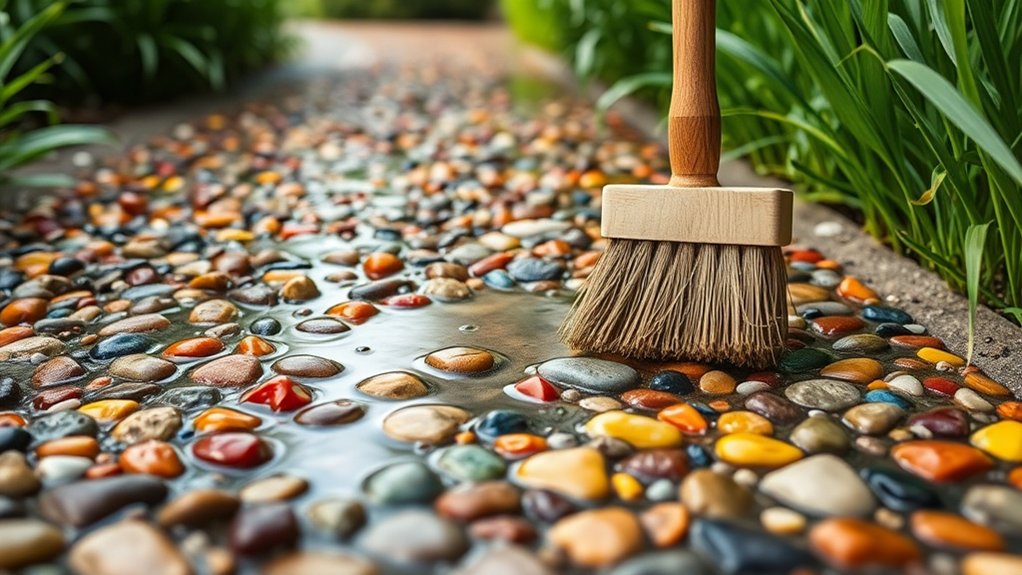
Environmental and usage factors play a crucial role in keeping resin-bound gravel surfaces safe and effective.
British weather, particularly heavy rain and damp conditions, can make surfaces slippery by creating a water film. Winter’s freeze-thaw cycles might cause small cracks that affect grip.
Think of a busy garden path or driveway – regular foot traffic and parked cars can wear down the stones over time, making them smoother. This becomes particularly troublesome when fallen leaves or mud block proper drainage.
Common issues like spilt oil, moss growth, or dead leaves can create dangerous slick patches, so regular sweeping and cleaning is essential.
Much like maintaining a garden path, you’ll need to consider both the weather’s impact and how the surface is used daily.
Regular checks and maintenance, especially after harsh weather, will keep your resin-bound gravel surface safe and slip-resistant throughout the year.
Best Practices for Long-lasting Grip
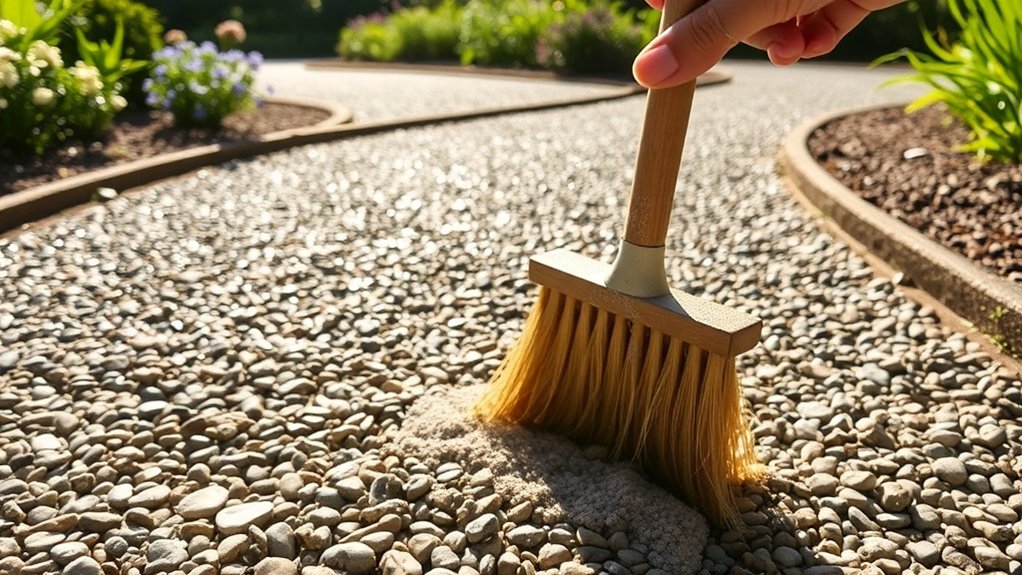
Best Practices for Long-lasting Grip
Maintaining grip on resin-bound gravel surfaces requires regular upkeep to ensure safety and slip resistance. Much like keeping a garden path clear, these simple maintenance steps help preserve the surface’s durability:
| Practice | Description | Frequency |
|---|---|---|
| Regular Cleaning | Sweep and wash surfaces to remove leaves and dirt | Weekly |
| Surface Inspection | Look for cracks and wear; sort repairs promptly | Monthly |
| Weed and Algae Control | Clear unwanted growth to maintain grip | Fortnightly |
| Gentle Cleaning Methods | Stick to soft brushes and light-pressure washing | When needed |
| Surface Treatments | Apply protective sealants against weather and wear | Every 1-2 years |
Think of it as maintaining your driveway – regular attention prevents bigger problems later. These straightforward steps keep surfaces safe and looking smart throughout British weather conditions.
Frequently Asked Questions
How Often Should Resin-Bound Gravel Be Cleaned?
Resin-bound gravel needs cleaning once or twice yearly, with weekly brushing to remove leaves and debris. Check monthly for moss and algae build-up, particularly during autumn and winter. Regular maintenance keeps the surface looking smart whilst maintaining proper drainage – crucial for British weather conditions.
Can Resin-Bound Gravel Be Installed Over Existing Surfaces?
Resin-bound gravel can be laid over existing surfaces, much like fitting a new carpet to a solid floor. Simply ensure your base surface is compatible and stable, then check it’s properly cleaned and prepared before installation. A sound foundation is crucial for proper bonding and lasting results.
What Is the Lifespan of Resin-Bound Gravel Installations?
Resin-bound gravel surfaces last between 15 and 30 years when properly installed and maintained. Much like a well-laid patio or driveway, the key to longevity lies in quality materials and expert workmanship. Regular sweeping and occasional pressure washing help maintain the surface, whilst proper drainage prevents water damage common to British weather conditions.
Are There Specific Cleaning Products to Avoid?
Avoid harsh cleaning products such as bleach, ammonia and acidic solutions, as these will damage resin surfaces. Steer clear of rough scrubbing materials or abrasive cleaners that could scratch or harm your resin-bound gravel – much like how you wouldn’t use a scouring pad on a non-stick pan.
How Does Weather Affect Resin-Bound Gravel Maintenance?
Weather plays a vital role in maintaining resin-bound gravel surfaces across the UK. Heavy rainfall can affect the bonding strength, whilst winter frost and cold spells may slow down the curing process for new installations or repairs. Regular checks, especially after harsh weather, help spot potential issues before they worsen. A quick sweep during autumn keeps fallen leaves from staining the surface, and a thorough clean in spring removes any winter grit or debris. These simple steps keep your resin-bound driveway or path looking smart throughout Britain’s changeable weather patterns.
Conclusion
Walking on resin-bound gravel can sometimes feel as slippery as an icy pavement, particularly in wet conditions. Proper installation and regular maintenance are essential to prevent this issue. Adding anti-slip treatments and following maintenance guidelines helps create a safer surface. Regular cleaning and upkeep, much like maintaining your driveway, ensures the surface remains both safe and durable for years to come.
